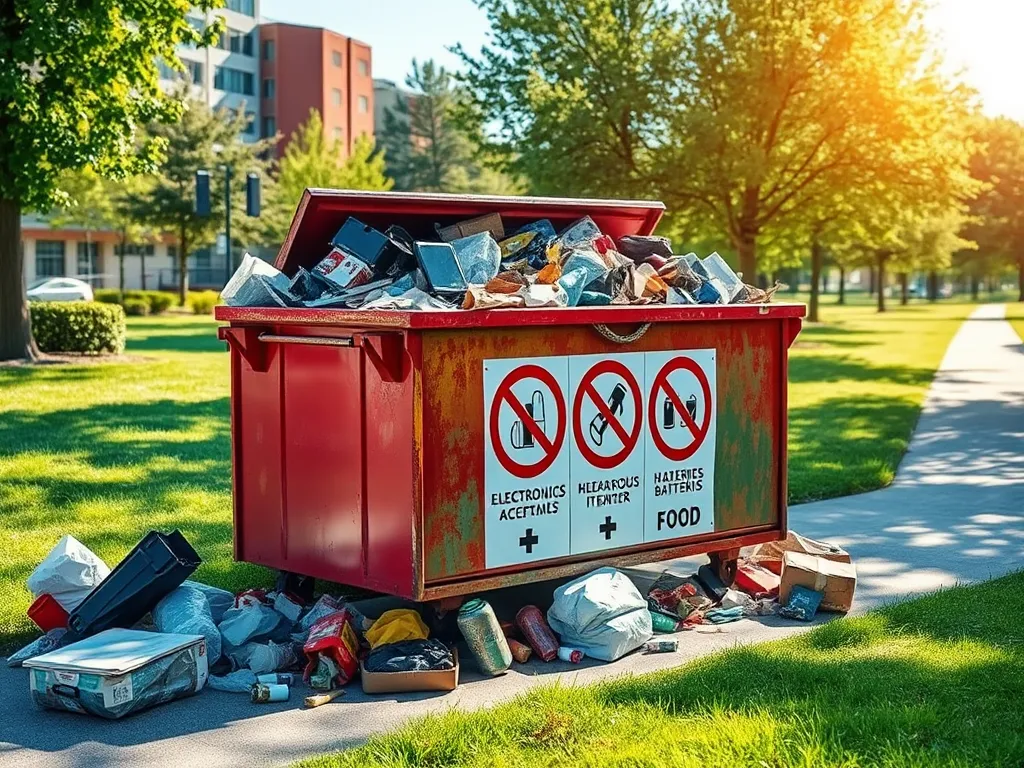Essential Guide to Prohibited Dumpster Items: What You Can't Toss

Prohibited Dumpster Items: What You Need to Know
When it comes to waste disposal, many people are unaware of the categories of prohibited dumpster items. Understanding these restrictions is essential for responsible waste management and to avoid legal consequences. Prohibited dumpster items can range from hazardous materials to bulky furniture and specific yard waste that can harm the environment or violate local regulations.
Improper disposal of prohibited dumpster items poses serious risks, including contamination of landfills, harm to sanitation workers, and potential fines. It is vital to educate ourselves about which items cannot be thrown away in standard dumpsters. This knowledge not only helps keep communities clean but also protects public health and safety.
In this article, we will explore the various categories of prohibited dumpster items, including household items, construction debris, yard waste, medical waste, and commercial waste. Each section will detail specific items that must be disposed of differently, along with tips on proper disposal methods.
By understanding the prohibited dumpster items, individuals and businesses can make informed decisions regarding waste disposal. Always check with local waste management authorities to ensure compliance with regulations, and remember, when in doubt, it's better to find the right disposal option than to risk penalties.
Let’s dive into the specific categories of prohibited dumpster items to gain a clearer understanding of what can and cannot be disposed of in a dumpster.
When planning your next project, be sure to familiarize yourself with the Dumpsters Restricted Items and Materials to ensure proper disposal.
Household Items
One of the most common categories of prohibited dumpster items includes hazardous waste found in many households. Items such as paints, cleaners, batteries, and certain pesticides contain toxic chemicals that can leach into the environment if disposed of improperly. These materials should be taken to designated hazardous waste collection sites to ensure safe disposal.
Additionally, large furniture items like sofas, mattresses, and old appliances are often prohibited from standard dumpsters due to their size and impact on landfill space. Many municipalities have bulk waste pick-up services or donation centers that accept these items in better condition.
Moreover, electronic waste such as TVs, computers, and monitors is another category of prohibited dumpster items. These electronics contain heavy metals and other hazardous materials that can be harmful to both the environment and human health. Recycling programs specific to e-waste are available to handle these items safely.
Construction Debris
Construction debris is another area where prohibited items frequently arise. Asbestos materials, for example, require special handling and disposal due to their harmful effects when disturbed. Professional asbestos removal services are mandated to mitigate health risks associated with exposure.
Moreover, while concrete and bricks are sturdy materials that may seem suitable for a dumpster, they are often subject to recycling regulations. Many locations require these materials to be taken to specific recycling facilities rather than being mixed with general waste.
Another concern is the disposal of toxic materials found in construction, such as chemicals and heavy metals. Regular dumpsters cannot accommodate these substances due to local environmental laws. Contractors must familiarize themselves with proper disposal regulations to ensure compliance and safety.
Yard Waste
Yard waste constitutes another category of prohibited dumpster items, especially when it comes to large tree branches. Instead of placing them in dumpsters, many cities offer curbside pick-up or drop-off options for recycling yard waste, including chipping services for branches.
Grass clippings and leaves are often allowed in composting bins, providing an eco-friendly way to dispose of organic waste. However, if composting is not an option, check local guidelines for proper methods of disposal.
Soil and dirt are typically prohibited from being dumped in standard dumpsters due to weight restrictions and environmental concerns. Many areas have specific disposal methods for excess soil, often related to landscaping projects or construction sites.
Medical Waste
Medical waste, primarily generated by hospitals and clinics, has strict regulations regarding disposal to prevent health hazards. Sharps like needles and scalpel blades must be disposed of in designated sharps containers to avoid injury to waste handlers.
Furthermore, medications cannot simply be thrown in the trash or dumped in a dumpster due to their potential to contaminate water systems. Proper disposal methods include returning them to designated pharmacies or participating in take-back programs organized by local authorities.
Biological waste, which can include anything from human tissue to infectious materials, also should never be disposed of in a dumpster. This type of waste needs to be handled by certified medical waste disposal companies to ensure safety and compliance with health regulations.
Commercial Waste
For businesses, there are specific prohibited items that require attention. Industrial chemicals often found in factories must be disposed of according to strict regulations to prevent environmental contamination. Companies are responsible for understanding the disposal requirements for these materials.
Medical facilities generate a unique type of commercial waste that includes products like used bandages and medical equipment. Handling and disposing of this waste are governed by stringent guidelines to protect the health of workers and the public.
Retail waste, including damaged goods or expired products, also falls into the category of prohibited dumpster items. Many retailers are required to follow specific disposal regulations to minimize environmental impact and ensure compliance with health standards.
